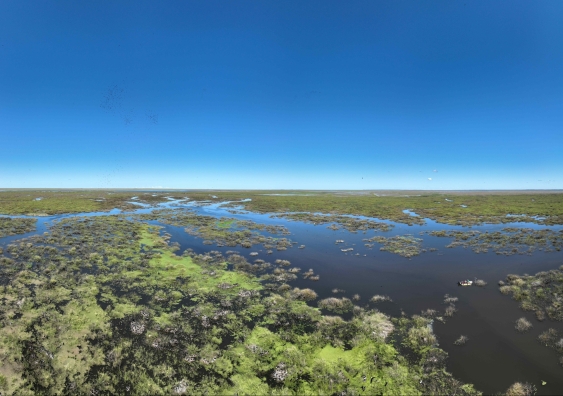Historic agreement seals permanent protection of Gayini wetlands
UNSW Sydney is part of a consortium supporting a conservation area that aims to restore a significant wetland.
UNSW Sydney is part of a consortium supporting a conservation area that aims to restore a significant wetland.

Olga Gerloff
UNSW Corporate Communications
0434 498 838
o.gerloff@unsw.edu.au
Nari Nari Tribal Council (NNTC) and the NSW Biodiversity Conservation Trust (BCT) have signed a historic agreement, securing the permanent protection and sustainable management of more than 55,000 hectares of land at Gayini, NSW, under the ownership and stewardship of its Traditional Custodians.
UNSW’s Centre for Ecosystem Science is part of a consortium that supports the new conservation agreement, the largest funded agreement ever established with a First Nations group in NSW. The agreement creates a Conservation Area under the stewardship of NNTC, to protect the natural and cultural values of the property. Alongside UNSW, other consortium partners include The Nature Conservancy and the Murray Darling Wetlands Working Group.
The Gayini Wetlands covers 88,000 hectares on the Lowbdigee Floodplain, the largest remaining area of wetlands in the Murrumbidgee in the southern Murray-Darling Basin. It is one of the more significant wetlands in the Murray-Darling Basin, a place of very high biodiversity and cultural values.
The property is owned and managed by the Traditional Custodians of the land, the Nari Nari Tribal Council. Gayini, the Nari Nari word for water, is one of the largest wetland restoration projects in Australia and features a mix of environmental and Indigenous conservation and sustainable farming.
The consortium of partners supporting the agreement takes direction from NNTC and assists with the research, reporting and management of this significant landscape.
Professor Richard Kingsford, Director of the Centre for Ecosystem Science, has a long history of working on the wetland. He welcomes the announcement.
“It’s great to see the Traditional Custodians in charge of the land and water, over such a large part of the Murrumbidgee. This agreement will be important for resourcing such a significant restoration. We are really looking forward to helping with our research and management expertise.”
“Nari Nari is proud to be leading the way in First Nation’s land and water management, with the announcement of this ground-breaking agreement,” NNTC chair, Jamie Woods, says.
Prof. Kingsford says there are going to be great opportunities to learn from Traditional Custodians about living and managing Country.
“We hope we can provide our expertise to increasingly improve the outcomes for this unique part of Australia.”
The large floods have inundated the area over the last few months, and have produced an amazing response from the wetlands. The Centre for Ecosystem Science has been using its expertise in drone technology to count and track large breeding colonies of waterbirds, including straw-necked ibis, Australian pelicans, royal spoonbills and cormorants.
Senior Research Fellow in the Centre for Ecosystem Science, Dr Kate Brandis, and her team are working on behalf of the Commonwealth Environmental Water Holder (CEWH), linking the breeding success of these colonies to the flooding and water quality.
“It is an incredible sight to see so many birds breeding in one place, a great example of a wetland in its fullest glory,” Dr Brandis says.
“It has been great tracking the young from eggs through their chick stage until they are able to fly.
"After starting in October last year, our monitoring is now nearly finished, and we’ll move on to writing up our research reports. These birds have had an amazing opportunity for breeding and building up waterbird populations."